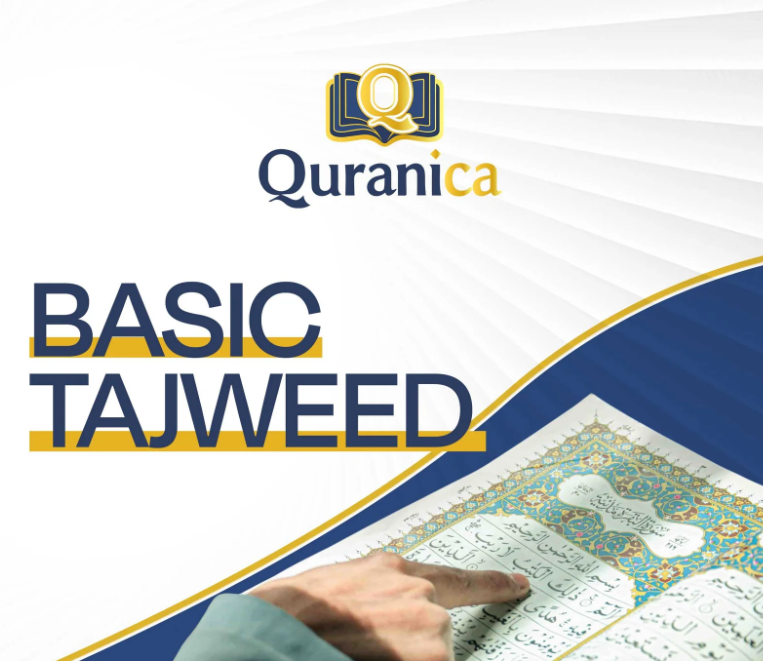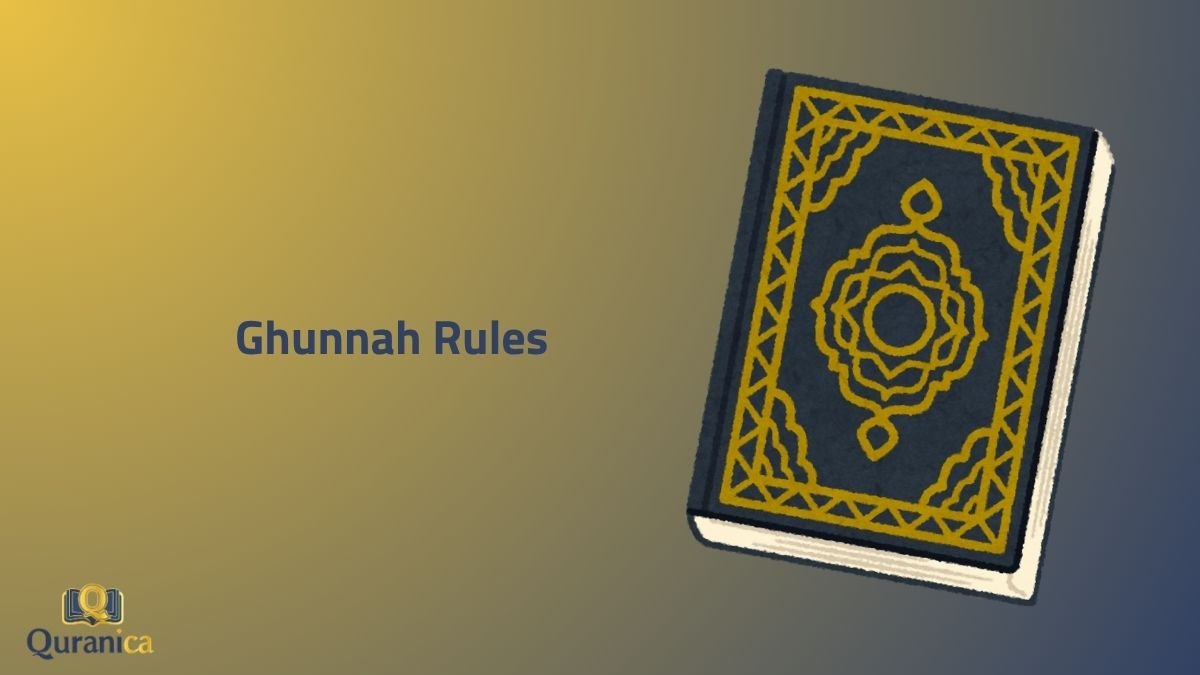Ghunnah is a nasal resonance central to Quranic Tajweed, specifically tied to the letters Noon (ن) and Meem (م). It becomes obligatory when these letters are doubled (Mushaddadah), requiring a two-beat nasal hold. Ghunnah also features prominently in Noon Sakinah and Tanween rules—Idgham (merging), Iqlab (flipping), and Ikhfa (hiding)—each with unique applications. Tajweed scholars classify Ghunnah into levels of intensity, from powerful and prolonged to subtle and brief.
Have you ever listened to a beautiful recitation and felt a vibration, a gentle hum that seems to make the words of Allah resonate deep within your soul?
That beautiful sound is often the Ghunnah. Mastering it is not just about learning a rule; it’s about unlocking a new layer of beauty and connection in your recitation.
Before we enter the formal science of Tajweed, it helps to understand what a word means in its original, everyday context.
What is Ghunnah in Arabic?
Linguistically, Ghunnah refers to a nasal sound, a “twang” or a “hum” that emanates from the nose. The word Ghunnah (غُنَّة) has a beautiful and descriptive root in the Arabic language.
Classical Arabs would use it to describe the sound a gazelle makes when she is filled with longing for her young fawn—a deep, resonant hum.
This connection to a sound of yearning and beauty gives us a clue about the aesthetic role Ghunnah plays in the recitation of the Holy Quran.
What is Ghunnah in Tajweed?
In the science of Tajweed, the formal definition of Ghunnah is: “A nasal sound that is emitted from the khayshum (the nasal passage), with no involvement of the tongue.”
This definition is precise and crucial. It tells us exactly where the sound comes from—the nose—and, just as importantly, where it doesn’t come from—the mouth or the tongue.
This sound is an inherent, inseparable quality of two specific letters, making its mastery non-negotiable for correct and beautiful Quranic recitation.
Ghunnah Rule
Ghunnah rules primarily revolve around the state of the letters Noon (ن) and Meem (م). We will explore the most straightforward and obligatory Ghunnah found on a Meem Mushaddadah (مّ) and Noon Mushaddadah (نّ).
Then, we will delve into the essential rules of Noon Sakinah and Tanween, where the Ghunnah is a key component of major concepts like Idgham (merging), Iqlab (flipping), and Ikhfa (hiding). Each rule simply defines the presence, length, and clarity of the nasal sound.
The Ghunnah Letters
The Ghunnah is a permanent, intrinsic characteristic (known in Tajweed as a sifah lazimah) of the letters Noon (ن) and Meem (م).
Yes, in the entire Arabic alphabet, only two letters are the exclusive carriers of this beautiful nasal sound. These letters are the foundation of all the Ghunnah rules you will ever learn.
This means that whether the letters Noon (ن) and Meem (م) have a vowel (fat’ha, damma, kasra) or are without a vowel (sakinah), the quality of Ghunnah is always present in them.
However, the key to mastering Tajweed is understanding that the duration and clarity of this Ghunnah change. Sometimes it is very short and subtle, and other times it is long and pronounced.
How to Pronounce Ghunnah
Understanding the physical mechanics of a sound is the first step to producing it correctly. Let us explore the simple action required to make a perfect and clear Ghunnah.
The sound of Ghunnah is produced entirely in the nasal cavity (al-khayshum). To feel this for yourself, I want you to try a simple exercise.
Gently place your thumb and index finger on the bridge of your nose. Now, close your lips and make a long, humming sound like ‘mmmmmmmmm’.
Next, keep your fingers there, touch the tip of your tongue to the roof of your mouth just behind your teeth, and make a long ‘nnnnnnnnn’ sound.
Do you feel that vibration in your nose?
That is the Ghunnah! This physical feedback is your personal guide to knowing you are producing the sound from the correct place.
Wajib Ghunnah
Now we move from the general quality to a specific, mandatory rule. The term Wajib in Arabic means obligatory or required, and this is the most emphatic form of Ghunnah.
Wajib Ghunnah refers to the application of the Ghunnah sound at its clearest and longest duration.
When you encounter a situation of Wajib Ghunnah, you are required to hold the nasal sound for a specific length of time, which scholars define as approximately two beats (or two harakahs).
There are two primary situations where this obligatory Ghunnah occurs, and they are very easy to spot.
Noon Mushaddadah (نّ) and Meem Mushaddadah (مّ)
The first and most obvious case of Wajib Ghunnah is when you see a Noon (ن) or a Meem (م) that has a Shaddah ( ّ ) symbol over it.
A Shaddah indicates that the letter is doubled: the first is sakinah (without a vowel) and the second has a vowel.
This doubling is what creates the most perfect and longest Ghunnah, a level scholars call Akmal ma takun (the most perfect it can be).
And here are some examples of Ghunnah in Tajweed
Examples of Ghunnah with Noon Mushaddadah from Quran
Here are some examples from the Quran. Listen for the extended nasal sound.
“إِنَّآ أَعْطَيْنَـٰكَ ٱلْكَوْثَرَ”
Innaa a’taynaka al-kawthar
“Indeed, We have granted you, [O Muhammad], al-Kawthar.”
Here, the Ghunnah on the Noon Mushaddadah (نَّ) in “Innaa” is held for approximately two beats, producing a clear, resonant nasal sound.
“مِّنَ ٱلْجِنَّةِ وَٱلنَّاسِ”
Mina al-jinnati wan-naas
“From among the jinn and mankind.”
In this verse from Surah An-Nas, you apply this full Ghunnah twice: once on the Noon Mushaddadah (نَّ) in “jinnati” and again on the Noon Mushaddadah (نَّ) in “an-naas.”
Examples of Ghunnah with Meem Mushaddadah from Quran
“ثُمَّ لَتُسْـَٔلُنَّ يَوْمَئِذٍ عَنِ ٱلنَّعِيمِ”
Thumma latus’alunna yawma’idhin ‘ani an-na’im
“Then you will surely be asked that Day about pleasure.”
In this verse, the Ghunnah is applied to the Meem Mushaddadah (مَّ) in “Thumma” and the Noon Mushaddadah (نَّ) in “latus’alunna.”
“فَأَمَّا ٱلْيَتِيمَ فَلَا تَقْهَرْ”
Fa’amma al-yateema fala taqhar
“So as for the orphan, do not oppress [him].”
Notice the clear, two-beat Ghunnah on the Meem Mushaddadah (مَّ) in the word “Fa’amma.”
If you are just beginning your journey, mastering these foundational rules is essential, and a structured program like Quranica’s Learn Tajweed for beginners Course can provide the guidance you need to build a strong base.

Ghunnah in Noon Sakinah and Tanween Rules
While the Ghunnah on a letter with a Shaddah is very clear, the beauty of Tajweed is also found in more subtle rules.
The Ghunnah is a central element in how we treat a Noon Sakinah (نْ) and Tanween (ـًـــٍـــٌ).
A Noon Sakinah is a Noon with no vowel, and Tanween is the double vowel at the end of a noun that produces an ‘n’ sound.
The rules that govern them are the cornerstone of proper recitation.
1. Idgham with Ghunnah
Idgham means “to merge.” When a Noon Sakinah or Tanween is followed by one of the letters ي (yaa), ن (noon), م (meem), or و (waw), we merge the Noon sound into the following letter. This merging is not silent; it is done with a clear Ghunnah.
“مَن يَقُولُ”
(May-yaqoolu)
“…those who say…”
Instead of “Man yaqoolu,” it is pronounced “May-yaqoolu” with a Ghunnah on the merged ‘y’ sound.
“وُجُوهٌ يَوْمَئِذٍ”
wujoohuy-yawma’izin
Faces, that Day.
Instead of “Wujoohun yawma’idhin,” it is pronounced “Wujoohuy-yawma’idhin” with a Ghunnah as the Tanween merges into the ‘y’.
Read more about: Idgham with Ghunnah And Without Ghunnah With Examples
2. Iqlab (Flipping) with Ghunnah
Iqlab means “to flip” or “to convert.” This rule applies in only one situation: when a Noon Sakinah or Tanween is followed by the letter Baa (ب).
Here, the ‘n’ sound is not pronounced clearly, nor is it merged.
Instead, it is “flipped” into a light Meem (م) sound, and this light Meem is then held with a clear Ghunnah before pronouncing the Baa.
“ٱلَّذِينَ يَنقُضُونَ عَهْدَ ٱللَّهِ مِنۢ بَعْدِ مِيثَٰقِهِ”
Alladheena yanqudoona ‘ahda Allahi mim ba’di meethāqih
“Who break the covenant of Allah after contracting it…”
Instead of “Min ba’di,” it is pronounced “Mim-ba’di,” with the lips lightly closed to produce the Ghunnah of the flipped Meem, then opening for the ‘ba’ sound.
3. Ikhfa (Hiding) with Ghunnah
Ikhfa means “to hide.” This rule applies when a Noon Sakinah or Tanween is followed by any of the 15 letters not covered by other rules.
In Ikhfa, we neither pronounce the Noon clearly nor merge it completely. Instead, we “hide” the Noon sound, preparing the mouth for the next letter while producing a Ghunnah from the nose.
The fascinating aspect of the Ikhfa Ghunnah is that its sound quality is influenced by the letter that follows it—sometimes it’s heavier, sometimes it’s lighter.
“عَن صَلَاتِهِمْ”
‘An salatihim
The tongue does not fully touch the point of articulation for the Noon. Instead, it hovers as you produce a Ghunnah, preparing to pronounce the thick letter ص.
Mastering this nuance is a sign of an advanced student, a skill honed in great detail within Quranica’s Advanced Tajweed Course.

The Levels of Ghunnah in Tajweed
As we become more sensitive in our recitation, we begin to notice that not all Ghunnahs sound the same. Some are long and powerful, while others are quick and subtle.
To help students perfect their timing and application, the great scholars of Tajweed beautifully categorized the Ghunnah into different ranks, or maratib.
Think of it like the shades of a single color—all are blue, but some are deep navy while others are a light sky blue.
Similarly, the Ghunnah is always present in the Noon and Meem, but its presence has different levels of strength and duration.
Understanding these levels is what separates a mechanical recitation from one that is truly precise, alive, and beautiful. It is the final layer of polish on your pronunciation. Let us walk through them.
1. Most Perfect Ghunnah (Akmal ma takun)
This is the Ghunnah at its peak performance—the most prolonged, most emphatic, and clearest of all the levels.
This is the obligatory (Wajib) Ghunnah we discussed, which must be held for a distinct duration of approximately two beats (harakahs).
Its sound is rich and completely nasal. You apply this highest rank of Ghunnah in two specific cases:
When you encounter a Noon Mushaddadah (نّ) or a Meem Mushaddadah (مّ)
During the rule of Idgham with Ghunnah (merging a Noon Sakinah/Tanween into ن, م).
2. Perfect Ghunnah (Kamilah)
This Ghunnah is also very clear and very present, but it is considered slightly shorter in duration than the “Most Perfect” level.
Why? Because here, the action of Ghunnah is happening at the same time as another action—either hiding the Noon or flipping it.
The sound is still a dominant feature of the recitation at this point. This is the Ghunnah that accompanies the rules of:
(Hiding the Noon Sakinah/Tanween)
Iqlab (Flipping the Noon Sakinah/Tanween into a Meem).
3. Incomplete Ghunnah (Naqisah)
This Ghunnah occurs when a Noon Sakinah (نْ) or Meem Sakinah (مْ) is pronounced clearly, which is the rule of Izhar. The key here is that the rule is clarity, not prolongation.
The inherent nasal quality of the letter is still present—it has to be, otherwise, you wouldn’t be pronouncing a Noon or Meem!—but you do not give it any extra time.
The Ghunnah simply exists for the brief moment it takes to articulate the letter clearly, with no holding.
Think of it this way: a person is always tall, even when they are sitting. The Ghunnah is always part of the Noon and Meem, even when its length isn’t being stretched.
4. Most Incomplete Ghunnah (Anqas ma takun)
This is the baseline Ghunnah, the most subtle level of all. It is the inherent nasal quality present on any voweled, or moving, Noon and Meem (e.g., نَ, نُ, نِ or مَ, مُ, مِ).
When you say the word نَعِيمِ (na’eem), the Ghunnah on the first letter (نَ) is instantaneous.
There is absolutely no holding or prolongation. It is the quickest of all the levels, representing the absolute minimum nasal resonance required to define the letter.
Distinguishing the precise timing between these levels, especially between the Perfect and Incomplete, is a skill that develops with guided practice.
For mastering this, there is no substitute for listening to a qualified teacher and using tools like Quranica’s Tajweed test and practice tools to refine your ear and your recitation.
Common Mistakes with Ghunnah
By knowing what to look out for, you can correct yourself early and build strong, correct habits from the very beginning. I have seen these issues many times, and they are all easily overcome with a little attention.
1. Incorrect Timing of Ghunnah
This is the most frequent mistake. Students either make the Ghunnah too short, cutting off the sound before its right is fulfilled, or they stretch it for too long, which can sound like humming or singing.
Remember, the duration of the Ghunnah is precise; for the Wajib Ghunnah, it is approximately two beats, not a random length.
2. Sounding Ghunnah from the Mouth
Many beginners produce a muffled sound from their mouth or throat instead of a clear, resonant sound from the nose.
The Ghunnah is a purely nasal sound (khayshum). If you don’t feel a distinct vibration in your nose when you make the sound, you are likely blocking the nasal passage and using your mouth instead.
3. Inconsistent Application of Ghunnah
A student might remember to perform a beautiful Ghunnah on a Noon Mushaddadah (نّ) but then completely forget it when the rule of Ikhfa or Iqlab appears just a few words later.
The goal is for the correct application of Ghunnah to become second nature in every situation that requires it.
Master Ghunnah in Your Recitation with Quranica
Now that you understand the rules, the next step is to put them into practice.
Mastering the Ghunnah truly transforms your recitation. It takes you from simply reading the words to reciting them with the feeling, beauty, and correctness that the words of Allah deserve.
It is a journey that brings immense spiritual reward and a deeper connection to the Holy Quran.
At Quranica, we are your dedicated partners on this blessed journey. We believe that every student deserves to learn the Quran from authentic, qualified teachers in a way that is both effective and encouraging.
Why choose Quranica?
Expert Tutors
Learn directly from native Arab instructors who are not only fluent in English but are also distinguished graduates of the prestigious Al-Azhar University.
Certified & Experienced
Our teachers are Ijazah-holders, meaning they have a certified chain of transmission back to the Prophet Muhammad (ﷺ). They have years of experience teaching Quran and Tajweed to non-Arabs just like you.
Personalized Learning
We understand that every learner is unique. We offer a range of courses tailored to your specific level and goals, from your first steps in Tajweed to advanced studies.
Competitive & Accessible
We are committed to making high-quality Quranic education affordable and accessible to Muslims all over the world.
Explore our key programs designed to meet your needs:
- Learn Quran with Tajweed (for all levels)
- Quran Memorization (Hifz) Programs
- Ijazah Course
- Islamic Studies
- Ten Qirat
- Arabic Lessons for Beginners
Explore our full range of courses.
Join a Quranica course today!

Conclusion
Ghunnah, a melodious nasal sound in Quranic recitation, enhances the spiritual beauty of Tajweed. Linguistically rooted in Arabic, it evokes the yearning sound of a gazelle, symbolizing the emotional depth it adds to recitation.
In Tajweed, Ghunnah is defined as a nasal vibration produced exclusively from the nose, independent of the tongue.
The two letters that inherently carry Ghunnah are Noon (ن) and Meem (م), regardless of whether they are voweled or not.
Ghunnah also plays a central role in the rules involving Noon Sakinah and Tanween, especially in Idgham (merging), Iqlab (flipping), and Ikhfa (hiding). Each rule requires a different application of the nasal sound—sometimes merging fully, sometimes flipping to a Meem, and sometimes subtly hiding the sound depending on the following letter.
Scholars classify Ghunnah into levels, from the most perfect (as in Wajib Ghunnah) to the most subtle (as in basic voweled sounds).
Understanding these levels allows a student to elevate their recitation from robotic to spiritually resonant. Recognizing and mastering the timing and clarity of each level is key.
Common mistakes include incorrect timing, producing the sound from the mouth, and inconsistency.








0 Comments